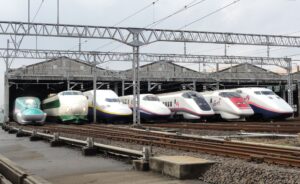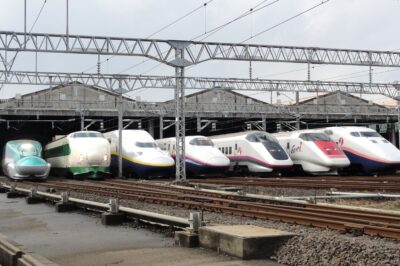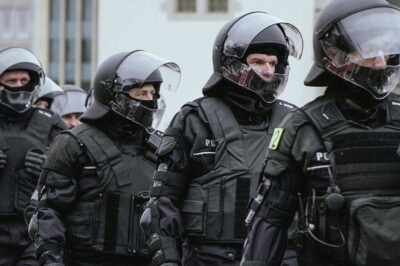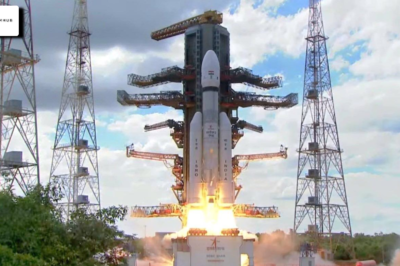Bullet trains trace their origins back to the early 20th century when the idea of high-speed rail travel began to take shape. Engineers and visionaries envisioned trains that could operate at unprecedented speeds, drastically reducing travel times between cities and regions.
The true genesis of the bullet train came with the launch of the Shinkansen in Japan in 1964. This groundbreaking project introduced the world to the concept of commercial high-speed rail travel, forever changing the landscape of transportation.
At the heart of a bullet train’s technology lies its advanced electromagnetic suspension system. By levitating the train slightly above the tracks, friction is minimized, allowing for smoother, quieter, and faster travel.
In Bullet train, there is three class (Seating class).
1-Normal class.
2-Green class(where we got foods and meals etc.)
3-Expensive Class(Where we got food -Drink etc. for that we have to pay money ).
Speed of the Bullet train
The speed of a bullet train can vary depending on the specific model and route. Generally, bullet trains are designed to operate at high speeds, often reaching speeds of up to 200 miles per hour (320 kilometers per hour) or more. However, some advanced models and experimental trains may achieve even higher speeds. It’s important to note that the speed of a bullet train is regulated and controlled based on safety considerations and the infrastructure of the rail network.
Why the speed of the Bullet train is very fast?
- Electromagnetic Suspension: Bullet trains use an advanced electromagnetic suspension system that allows the train to levitate slightly above the tracks. This reduces friction between the train and the tracks, allowing for smoother movement and less energy loss.
- Aerodynamic Design: The shape and design of bullet trains are carefully engineered to minimize air resistance, allowing them to slice through the air more efficiently. This aerodynamic design helps the trains maintain stability and reach higher speeds.
- Electric Propulsion: Bullet trains are powered by electricity, which provides instant torque and allows for quick acceleration. Electric propulsion systems are highly efficient and can maintain high speeds over long distances.
- Dedicated High-Speed Rail Lines: Bullet trains operate on dedicated high-speed rail lines that are designed to accommodate their high speeds. These tracks have gentle curves and gradients, reducing the need for speed reductions and allowing the trains to maintain consistent high velocities.
- Safety Measures: Advanced safety systems and controls are implemented to ensure the safety of passengers and the train itself at high speeds. These include automatic train control systems and various safety features to prevent accidents and ensure smooth operations.
- Continuous Improvement: Over the years, technological advancements and continuous research and development efforts have led to the refinement of bullet train designs. This has resulted in improved efficiency, reduced energy consumption, and higher top speeds.
Track Design of Bullet Train
The track design of a bullet train, also known as a high-speed rail line, plays a crucial role in ensuring the safe and efficient operation of these fast-moving trains. The following are some key aspects of the track design for bullet trains:
- Dedicated Tracks: Bullet trains operate on dedicated tracks that are separate from conventional railway lines. These tracks are designed exclusively for high-speed travel, allowing the trains to reach their maximum speeds without interference from slower-moving trains.
- Gentle Curves and Gradients: High-speed rail lines are designed with gentle curves and gradients to minimize lateral forces on the train and ensure a smooth ride at high speeds. Sharp curves are avoided to prevent discomfort for passengers and reduce wear and tear on the train and tracks.
- Banked Curves: In some cases, curves on high-speed rail lines are banked, meaning the tracks are tilted inward. This design helps to counteract the centrifugal forces acting on the train as it negotiates the curve, allowing for safer and more stable travel.
- Continuous Welded Rails: Bullet train tracks often use continuous welded rails, where long sections of rail are welded together to create a seamless and smooth track surface. This eliminates the jolts and vibrations that can occur at rail joints and enhances the overall stability of the train.
- Concrete Sleepers: High-speed rail lines typically use concrete sleepers (ties) instead of traditional wooden ones. Concrete sleepers offer greater stability and durability, which is essential for maintaining the track’s integrity at high speeds.
- Grade Separations: To avoid conflicts with other forms of transportation, such as road traffic, high-speed rail lines often incorporate grade separations. This means the tracks are elevated or placed in tunnels to prevent intersections with roads and pedestrian crossings.
- Safety Features: High-speed rail lines are equipped with various safety features, such as signaling systems, automatic train control, and train protection systems. These technologies help maintain safe distances between trains, regulate speed, and prevent collisions.
- Maintenance and Inspection: Regular maintenance and inspection of the tracks are critical to ensuring the safety and efficiency of bullet trains. High-speed rail operators conduct routine checks to identify and address any issues that may arise.
Controlling of Bullet Train.
The controlling of Bullet Train is Totally Automatic (ATC) . The Bullet Train drivers have not any controlling power like(signals ,Stop-time ,Speed controlling etc.) So the manual controlling is Zero.
- The Stations are very less about 1000km only 4 Station . So because of that the Bullet train maintain the speed about 311km/h to 320km/h .
- The travelling time of 1000km is only 3 hour’s.
- The two bullet Train never crossing because There is long distance Between Two Train Track.
All about by the Socialmhub.com.



